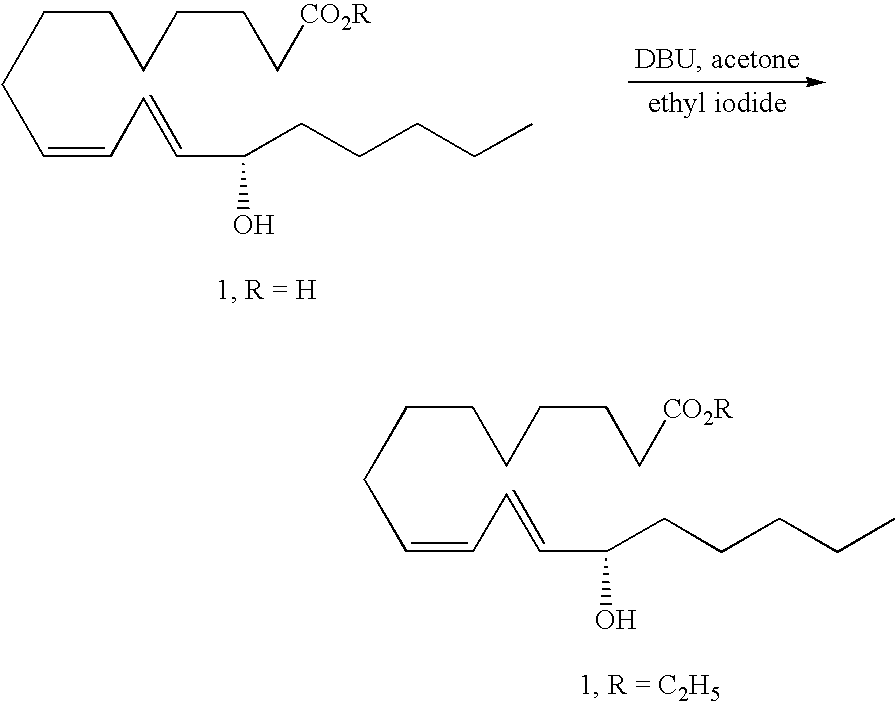Method of treating dry eye disorders using 13(S)-HODE and its analogs
- Summary
- Abstract
- Description
- Claims
- Application Information
AI Technical Summary
Problems solved by technology
Method used
Image
Examples
example 1
[0043] Synthesis of Compound 1 (R=C2H5)
[0044] A solution of 13S-HODE (1, R=H), acetone, 1,8-diazabicyclo[5.4.0]undec-7-ene (DBU), and ethyl iodide is stirred for 16 h to provide 13S-HODE ethyl ester (1, R=C2H5) after aqueous workup and chromatographic purification.
example 2
[0045] Synthesis of Compounds 2 (R=H, CH3, and C2H5)
[0046] 9-Hydroxynonanoic acid (8; commercially available from Matrix Scientific Corporation, Post Office Box 25067, Columbia, S.C. 29224-5067) is oxidized to aldehyde 9 using catalytic 2,2,6,6-tetramethyl-piperidinoxyl free radical (TEMPO) and stoichiometric N-chlorosuccinimide (NCS) in a rapidly stirring mixture of CH2Cl2, water, and catalytic n-Bu4NHSO4. Conversion of 9 to cis-vinyl iodide 10 is effected using Ph3PCH2I2 and NaN(SiMe3)2 (NaHMDS) in THF / HMPA. Sonogishira coupling of 10 with (3S)-1-octyn-3-ol (11; commercially available from Aldrich Chemical Co., Post Office Box 355, Milwaukee, Wis. 53201) is accomplished using in HNEt2 as solvent using stoichiometric CuI and catalytic Cl2Pd(PPh3)2 provides enyne 2 (R=H). Treatment with CH2N2 in diethyl ether affords the methyl ester 2 (R=CH3), while treatment with Etl and DBU in acetone yields ethyl ester 2 (R=C2H5).
example 3
[0047] Synthesis of Compounds 3 (R=H, CH3, AND C2H5)
[0048] 1,9-nonanediol (12) is monoprotected using 0.9 equivalents of t-butyldiphenylchlorosilane in THF containing stoichiometric imidazole and catalytic N,N-dimethylaminopyridine (DMAP), to afford monosilyl ether 13. Swern oxidation using (COCl)2, dimethylsulfoxide (DMSO), and NEt3 in CH2Cl2 at −78° C. gives aldehyde 14, which is olefinated with CBr4 in CH2Cl2 in the presence of Zn and PPh3 to give dibromoolefin 15. Metal-halogen exchange in THF at −78° C. is followed by quenching with N-bromosuccinimide (NBS) to afford bromoalkyne 16. Sonogashira coupling with octynol 11 is effected using catalytic Cl2Pd(PPh3)2 and stoichiometric Cul in HNEt2 solvent to provide diyne 17, which is reduced to trans-ynene 18 with LiAlH4 in diethyl ether. Silyl ether deprotection with n-Bu4NF in THF gives diol 19, which is oxidized to aldehyde 20 using stoichiometric NCS and catalytic TEMPO in CH2Cl2 / water containing catalytic n-Bu4NHSO4. Oxidation...
PUM
| Property | Measurement | Unit |
|---|---|---|
| Fraction | aaaaa | aaaaa |
| Fraction | aaaaa | aaaaa |
| Fraction | aaaaa | aaaaa |
Abstract
Description
Claims
Application Information
 Login to view more
Login to view more - R&D Engineer
- R&D Manager
- IP Professional
- Industry Leading Data Capabilities
- Powerful AI technology
- Patent DNA Extraction
Browse by: Latest US Patents, China's latest patents, Technical Efficacy Thesaurus, Application Domain, Technology Topic.
© 2024 PatSnap. All rights reserved.Legal|Privacy policy|Modern Slavery Act Transparency Statement|Sitemap



